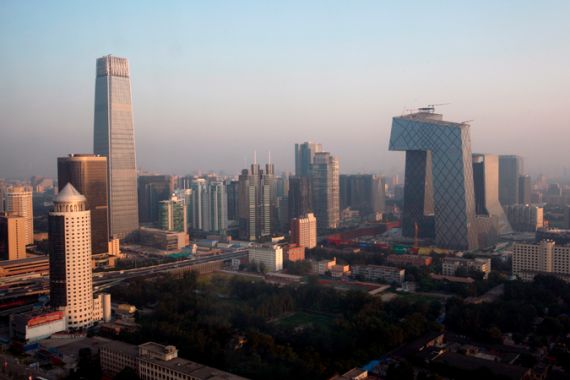China’s economy beats expectations with 4 percent growth in Q4
Chinese economy expands 8.1 percent for the whole of 2021 amid weakest Q4 growth in more than a year.

China’s economy grew 4 percent in the final quarter of 2021 to expand 8.1 percent year-on-year, amid stronger-than-expected industrial production in December, government data showed on Monday.
Though coming in higher than the 3.6-percent growth predicted by analysts, the Q4 figure is the weakest growth the country has seen in a year and a half.
Keep reading
list of 4 itemsThousands protest against Dutch COVID restrictions
North Korea fires two suspected ballistic missiles, Seoul says
China’s birth rate drops to record low
The slowing growth comes as China grapples with a deepening property crisis, constraints on energy consumption, shipping disruptions and reduced domestic spending.
Debt troubles at some of the country’s largest real estate developers have pushed homebuyer confidence and property purchases to an all-time low. Property investment growth is at its weakest since 2015 when Beijing rolled out its “houses are built to be inhabited, not for speculation” campaign to curb excessive construction by restricting loans to overleveraged developers.
“The Evergrande debt default had a chilling effect on construction and property development, and likely indicates balance sheet issues at other property firms,” said Tommy Wu, lead China economist for Oxford Economics in Hong Kong. “Real estate investment accounts for the largest fraction of GDP, and slowdown in construction has an outsized effect on overall growth. We expect the property downturn to extend into the first half of this year before real estate activity recovers somewhat in the second half.”
Shehzad Qazi, managing director of Beijing Beige Book International, told Al Jazeera he did not foresee a major shift in the direction of economic policy this year despite some policy easing.
“Policy easing is pretty much guaranteed in 2022 because this is a Party Congress year,” Qazi said. “That said, easing will be a temporary political reprieve, not a sustained new economic approach. Market analysts are overhyping the prospects of big stimulus. While credit conditions will loosen after an exceptionally tight 2021, Beijing’s policy easing will be temporary and targeted. The large stimulus seen in previous Party Congress years is simply not in the books.”
China has pledged to transition towards green energy and reduce greenhouse gas emissions, adding additional short-term challenges to economic growth.
In September, Beijing announced it would reduce carbon emissions and coal production with the aim of becoming carbon neutral by 2060. But efforts last year to cut down on carbon-emitting processes resulted in power shortages across the country, disrupting manufacturing and reducing output at factories, including those supplying goods to Apple and Tesla.
“A relatively new, but tightening, constraint on growth comes from increased regulatory pressure to meet environmental targets for energy consumption and energy intensity,” Goldman Sachs economists said in a September report. “Meanwhile, efforts to reduce coal-fired related emissions and a reduction in coal imports have affected supply levels at least on the margin, contributing to a sharp increase in prices.”
‘Disappointing consumption growth’
While demand for China-made goods remains high, supply chain issues, logistical bottlenecks, and problems tracking shipping traffic have slowed economic activity. Analysts are watching to see if China’s shipping industry can smooth out these disruptions and alleviate the risk of businesses relocating manufacturing bases.
“How consumption recovers next year will have a very great impact on the economy,” Jianguang Shen, chief economist at Chinese e-commerce company JD.com, said in an interview with CNBC last month.
Analysts are also closely watching the course of the pandemic for its impact on domestic consumption, which will be an important predictor of economic recovery.
Lockdowns and other pandemic restrictions have kept domestic consumer spending sluggish, which has been exacerbated by slow income growth. In recent weeks, three large Chinese cities – Xi’an, Tianjin and Anyang – have been locked down due to the emergence of cases of the Omicron variant.
Oxford Economics’ Wu said COVID flareups that had prompted restrictions in affected areas and heightened caution nationwide had especially hurt demand for services.
“We think that China is unlikely to relax its zero-tolerance approach to COVID until late-2022 at the earliest. As a result, we project disappointing consumption growth this year, especially in the first half of the year,” Wu said.
To prevent growth from falling below 5 percent, Beijing has rolled out policy easing measures in recent months, including loosening credit and bond issuance controls for under-pressure property developers. In a surprise move, the People’s Bank of China announced on Monday the first reduction in borrowing costs for medium-term loans since April 2020.
“To put a floor under economic growth, we expect strong infrastructure spending, robust credit growth, and adequate support for the real estate sector this year,” Wu said.